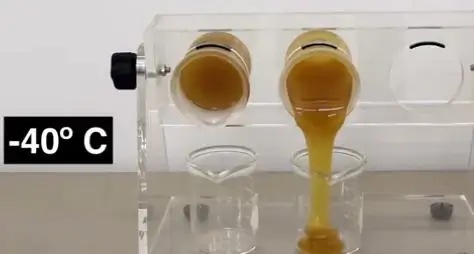You don’t have to warm up your engine to get good oil flow in winter
If you’re really concerned about getting oil flowing in winter, drive it, don’t idle it
It’s a myth that you have to warm up your engine to get oil flow in winter.
Oil flow in winter has nothing to do with gravity — it’s about pumpability
Amsoil has a youtube video that shows conventional and synthetic oil being poured from beakers at -40C. The results show the conventional oil barely moving, while the synthetic oil flows!
 What you are seeing in this video is a comparison of conventional oil’s Kinematic viscosity compared to synthetic oil’s Kinematic viscosity. And what you’re seeing is completely irrelevant to what actually happens inside your engine.
What you are seeing in this video is a comparison of conventional oil’s Kinematic viscosity compared to synthetic oil’s Kinematic viscosity. And what you’re seeing is completely irrelevant to what actually happens inside your engine.
Why? Because oil doesn’t flow up from the oil pan and into your engine by gravity. It’s pumped. So a gravity pour and kinematic viscosity has nothing to do with an oil’s pump ability.
The first number in motor oil viscosity, the “W” number isn’t calculated based on its kinematic viscosity. Instead, it’s measured by the oil’s absolute viscosity, or how well it’s able to be pumped. As long as you’ve installed the proper viscosity oil for your engine, you will get enough oil flow to protect metal components as soon as the oil light goes out.
Oil pumps in modern engines are designed to pump enough oil to lubricate a cold engine.
Coolant temperature is not the same as oil temperature and idling doesn’t warm your oil
Engine coolant gets heated mostly in the cylinder heat due to high combustion temperatures. But oil warms up in the bearings due to internal friction and engine load. However, idling your engine places minimal load on the oil, which results in minimal oil warming. In extremely cold weather, any heat the oil does pick up in the engine is immediately lost as the oil returns to a cold sump. So, if you think you’re warming up your oil by idling your engine, think again. Driving it is what warms up your oil.
How to drive your car after starting in cold weather
Most carmakers recommend driving a modern fuel injected engine within 30-sec to 2-mins after startup. Then drive with light acceleration for the first few miles or so. You have enough oil flow in winter as soon as your start the engine and driving will warm up the oil much faster than idling.
Cold start advice from the Energy and Transportation Sciences Division of Oak Ridge National Laboratories
“Light-duty vehicles are ready to be driven at start up, and neither medium nor heavy-duty vehicles need long warm up periods. According to many original equipment manufacturers (OEMs), idling can actually be damaging to an engine and vehicle components. This is because idling can produce sulfuric acid, which can eat away at the engine and other components.
Additionally, idling results in lower in-cylinder temperatures combustion, which can produce additional soot, creates buildup in the engine, and causes unnecessary engine wear. Based on the potential for engine damage, drivers should avoid idling whenever possible. Generally speaking, more than 5 minutes of idling is excessive and should be avoided.” — Summary of OEM Idling Recommendations from Vehicle Owner’s Manuals
Energy and Transportation Sciences Division June 2016 prepared for the U.S. Department of Energy
©, 2023 Rick Muscoplat
Posted on by Rick Muscoplat
